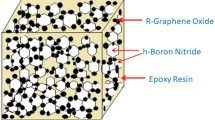Abstract
Sensors based on carbon-black-filled bisphenol A-type epoxy conductive polymeric composites (CPCs) have been prepared and applied to monitor thermal oxidation aging of polymeric materials. Thermogravimetric analysis (TGA) is applied to characterize weight loss of epoxy resin in the aging process. By using a mathematical model based on the Boltzmann equation, a relationship between the electrical resistivity of the sensors based on epoxy/carbon black composites and aging time is established, making it possible to monitor and estimate the aging status of polymeric components in situ based on a fast and convenient electrical resistance measurement.
Similar content being viewed by others
Abbreviations
- p c :
-
Percolation threshold
- C :
-
Relative weight of epoxy resin matrix
- W :
-
Real-time weight of epoxy resin
- W 0 :
-
Initial weight of epoxy resin
- t :
-
Aging time
- k :
-
Reaction constant
- n :
-
Exponent in power equation for weight of epoxy resin
- E a :
-
Activation energy in degradation of epoxy resin
- T :
-
Aging temperature
- R :
-
Gas constant
- ρ :
-
Electrical resistivity of CPCs
- ρ 0 :
-
Initial electrical resistivity of CPCs
- ρ ∞ :
-
Electrical resistivity of CPCs with infinite aging time
- x :
-
Weight ratio of carbon black
- α :
-
Exponent in electrical resistance alteration around percolation in Liang’s theory13
- t c :
-
Induction time, corresponding to aging time needed for a change of log ρ from log ρ 0 to \( \left(\log \rho_{0}+\log \rho_{\infty}\right)/2\)
- Δt :
-
A constant in the Boltzmann equation
References
A.I. Eatah, A.A. Ghani, and A.A. Hasham, Polym. Degrad. Stab. 23, 9 (1989).
K.T. Gillen, M. Celina, and R.L. Clough, Radiat. Phys. Chem. 56, 429 (1999).
L.R. Mason and A.B. Reynolds, J. Appl. Polym. Sci. 66, 1691 (1997).
K. Watkins, S. Morris, C.P. Wong, S. Luo, and D.D. Masakowski, U.S. Pat. Pending
Y.Y. Sun, S. Luo, K. Watkins, and C.P. Wong, Polym. Degrad. Stab. 86, 209 (2004).
Y.Y. Sun, L. Fan, K. Watkins, J. Peak, and C.P. Wong, J. Appl. Polym. Sci. 93, 513 (2004).
R. Zhang, W. Lin, K.-S. Moon, Q.Z. Liang, and C.P. Wong, IEEE Trans. Compon. Packag. Manuf. Technol. 1, 25 (2011).
N. Grassie, M.I. Guy, and N.H. Tennent, Polym. Degrad. Stab. 13, 11 (1985).
J.S. Chen, C.K. Ober, M.D. Poliks, Y. Zhang, U. Wiesner, and C. Cohen, Polymer 45, 1939 (2004).
Q. Liang, K.-S. Moon, H. Jiang, and C.P. Wong, IEEE Trans. Compon. Packag. Manuf. Techn. 2, 1571 (2012).
Q. Liang, S.A. Hsie, and C.P. Wong, ChemPhysChem 13, 3700 (2012).
Q. Liang, X. Yao, W. Wang, Y. Liu, and C.P. Wong, ACS Nano 5, 2392 (2011).
P. Musto, G. Ragosta, P. Russo, and L. Mascia, Macromol. Chem. Phys. 202, 3445 (2001).
A.R. Greenberg and I. Kamel, J. Polym. Sci. Pol. Chem. 15, 2137 (1977).
N.T. Liang, Y. Shan, and S.Y. Wang, Phys. Rev. Lett. 37, 526 (1976).
X.K. Yin and B.Z. Sheng, IEEE Trans. Reliab. 36, 150 (1987).
D. Suryanarayana, R. Hsiao, T.P. Gall, and J.M. Mccreary, IEEE Trans. Compon. Hybr. Manuf. Techn. 14, 218 (1991).
S. Kirkpatrick, Rev. Mod. Phys. 45, 574 (1973).
L.F.E. Jacques, Prog. Polym. Sci. 25, 1337 (2000).
Author information
Authors and Affiliations
Corresponding author
Rights and permissions
About this article
Cite this article
Liang, Q., Nyugen, M.T., Moon, KS. et al. A Kinetics Study on Electrical Resistivity Transition of In Situ Polymer Aging Sensors Based on Carbon-Black-Filled Epoxy Conductive Polymeric Composites (CPCs). J. Electron. Mater. 42, 1114–1121 (2013). https://doi.org/10.1007/s11664-013-2525-z
Received:
Accepted:
Published:
Issue Date:
DOI: https://doi.org/10.1007/s11664-013-2525-z




